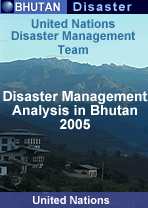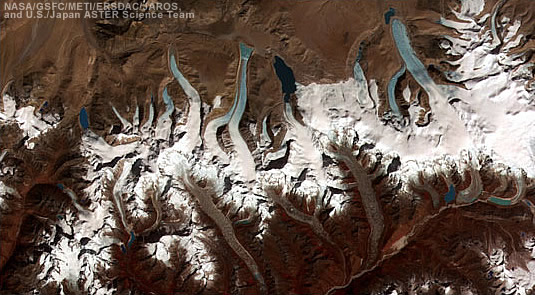| Bhutan's
glaciers and glacial lakes |
 |
Bhutan Glaciers - Glacial Lakes |
|
 |
Bhutan Glaciers - Glacial Lakes |
|
|
 |
|
GLOF
remains the biggest hazard for Bhutan |
|
Glacial
Lake Outburst Floods (GLOF) |
 |
Bhutan
pursues environment and its management as an integral part of its development
plan. Securing an intact environment also forms one of the pillars of Gross
National Happiness. The Forest and Nature Conservation Act and the draft
Constitution of the country require that at least 60% of the country remain
forested at all times. Currently, over a quarter of Bhutan's land has been
set aside as protected areas in the form of parks and biological corridors.
Diversity in flora and fauna is one of the highest in Asia. Bhutan is also
one of the few countries in the world with net greenhouse gas sequestration
capacity largely due to its vast forest cover and widespread use of clean
energy.
|
Bhutan's glacial lakes
| However,
Bhutan is not spared the adverse effects of global climate change, ozone
depletion or the loss of biodiversity. Natural disasters in the form of
, landslides, forest fires disrupt and endanger lives and threaten the
livelihoods of the people. |
|
These
natural disasters take tremendous toll on development often negating development
efforts and threatening prospects of achieving the Millennium Development
Goals (MDGs).
As
a key partner of the Government in sustainable environment management,
UNDP has been working closely with the Government to strengthen national
capacity to address these challenges relating to climate change. This has
been carried out through the Greenhouse Gas Project which began in 1996
and the National Programme of Action for Adaptation to Climate Change (NAPA),
which concluded recently. NAPA is a process initiated in the Least Developed
Countries (LDCs) to identify urgent and immediate projects and activities
that can help communities adapt to the adverse effects of climate change.
Taking into consideration all the different dimensions of climate vulnerability,
the NAPA process in Bhutan recommended a national disaster risk management
framework as a top priority.
Consequently,
the Government with support from the UNDP in partnership with other resident
UN agencies have developed a National Disaster Management Framework in
2006. The next step would be the operationalisation of the Framework through
a joint Disaster Risk Management Programme, to be formulated jointly by
the Government, UN agencies and other development partners in 2007. The
Framework points out that disaster resilience must be based on multi-disciplinary
and multi-stakeholders' approach, requiring collaboration and coordinated
action across sectors at all levels.
Another
important recommendation of the NAPA process is the urgent need to reduce
the water levels of the potentially high risk glacial lakes, namely the
Thorthormi(Thortomi) and Raphstreng lakes, to mitigate the immediate threat
posed by these lakes outburst to the population residing in the Punakha-Wangdi
and Chamkar valleys in central Bhutan. The worst case scenario, according
to some studies predicts the collapse of the wall separating the two glacial
lakes as early as 2010, which could result in huge devastation downstream.
UNDP with funds from the Global Environment Facility (GEF) is helping the
Government translate the NAPA concepts into ground reality and developing
the capacity of the Government and the local communities to adapt to the
vulnerabilities related to climate change. This will include assessing
the most suitable early warning systems for GLOF threat in the Punakha-Wangdi
valley, the implementation of hazard zonation and vulnerability mapping
for the valleys including capacity building for climate change-induced
disaster risk management at the national, intermediate and local levels.
An inception workshop on the project was held in Punakha on 24 January
with the participation of key stakeholders from the Government, the district
administration officials and representatives from the local communities
of Punakha, Wangdi and Chamkar in Bumthang. The one-year project, will
be executed by the Department of Geology and Mines with financial assistance
amounting to US$430,000 funded jointly by UNDP and GEF.
Glacial
Lake Outburst Floods (GLOF) is one of the biggest hazards the country will
continue to face given its numerous rivers which are glacial fed. Of the
2,674 glacial lakes in the country, 24 of them have been identified as
potentially dangerous, posing threat of GLOF at any time.
top
|
Building
Bhutan's resilience to Climate Change |
 |
The
National Adaptation Programme of Action (NAPA) is a process initiated in
the Least Developed Countries (LDC) to identify urgent and immediate projects
and activities that can help communities adapt to the adverse effects of
climate change.
During
2005, The Royal Government of Bhutan carried out an assessment of the possible
impact of climate change on various sectors: Health, agriculture, forest
and biodiversity, water and energy, infrastructure and disasters and eventually
identified nine priority projects.
Owing
to the fact that Bhutan is highly vulnerable to the glacial lake outburst
floods that could in a worst-case scenario result in huge loss of lives,
infrastructure and damage to the environment, the stakeholders prioritized
mitigating the threat from GLOF as the top priority under the NAPA, The
current project has been developed by the RGOB and UNDP with a total fund
of USD 3.4 million from the Global Environment Facility (GEF) and will
focus on the following:
1.
Artificial lowering ofThorthormi Glacial Lake
2.
GLOF hazard zoning in Chamkhar Chu basin and
3.
Installation of Early Warning System in the Pho Chu basin
The
current phase of the project will be implemented from December 2006. The
UNDP Resident Representative, the Director of Department of Geology and
Mines and the Department of Aid and Debt Management signed the project
document at the NEC conference hall. The Deputy Minister, NEC, the Director
General DADM, the Deputy RR, UNDP and the ARR Energy and Environment, UNDP
were also present at the signing.
| Source:
UNDP Bhutan - United Nations Development Programme,
2007 |
 |
|
Information
|
 |
 |
| Source: United Nations Disaster Management Team, 2005 |
|
Links
|
 |
 |
 |
External
links |
 |
 |
 |
 |
 |
| GRID-Arendal
News |
NASA's
Global Change Master Directory |
United
Nations Environment Programme |
World
Glacier Monitoring Service |
International
Centre for Integrated Mountain Development |
|
 |
 |
 |
|
|




